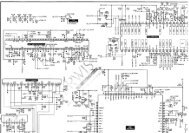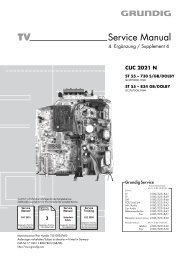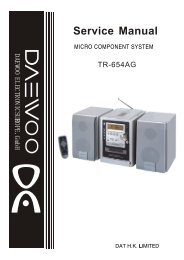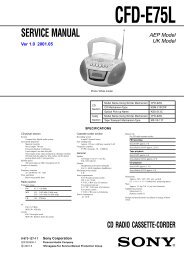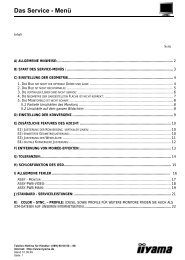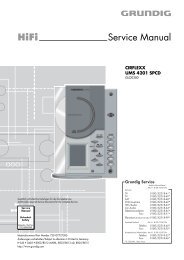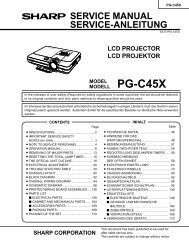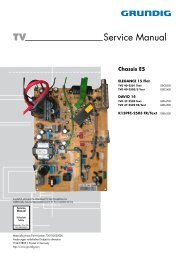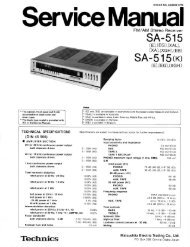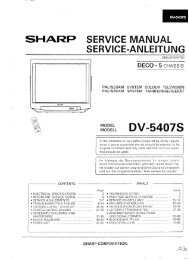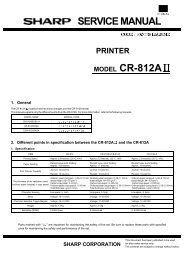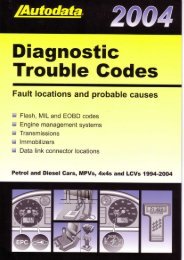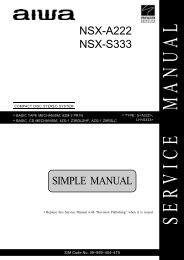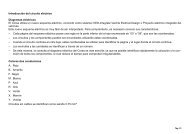Create successful ePaper yourself
Turn your PDF publications into a flip-book with our unique Google optimized e-Paper software.
Pb(Lead) Free Solder<br />
When soldering , be sure to use the pb free solder.<br />
INDENTIFICATION:<br />
Regardless of special logo (not always indicated)<br />
one must treat all sets from 1 Jan 2005 onwards, according<br />
next rules:<br />
Important note: In fact also products of year 2004 must<br />
be treated in this way as long as you avoid mixing solderalloys<br />
(leaded/ lead-free). So best to always use SAC305<br />
and the higher temperatures belong to this.<br />
Due to lead-free technology some rules have to be<br />
respected by the workshop during a repair:<br />
• Use only lead-free solder alloy Philips SAC305 with<br />
order code 0622 149 00106. If lead-free solder-paste<br />
is required, please contact the manufacturer of your<br />
solder-equipment. In general use of solder-paste<br />
within workshops should be avoided because paste is<br />
not easy to store and to handle.<br />
• Use only adequate solder tools applicable for leadfree<br />
solder alloy. The solder tool must be able<br />
– To reach at least a solder-temperature of 400°C,<br />
– To stabilize the adjusted temperature at the soldertip<br />
– To exchange solder-tips for different applications.<br />
• Adjust your solder tool so that a temperature around<br />
360°C – 380°C is reached and stabilized at the solder<br />
joint. Heating-time of the solder-joint should not exceed<br />
~ 4 sec. Avoid temperatures above 400°C otherwise<br />
wear-out of tips will rise drastically and flux-fluid will<br />
be destroyed. To avoid wear-out of tips switch off unused<br />
equipment, or reduce heat.<br />
• Mix of lead-free solder alloy / parts with leaded solder<br />
alloy / parts is possible but PHILIPS recommends<br />
strongly to avoid mixed solder alloy types (leaded and<br />
lead-free).<br />
If one cannot avoid or does not know whether product<br />
is lead-free, clean carefully the solder-joint from old<br />
solder alloy and re-solder with new solder alloy<br />
(SAC305).<br />
• Use only original spare-parts listed in the Service-<br />
Manuals. Not listed standard-material (commodities)<br />
has to be purchased at external companies.<br />
• Special information for BGA-ICs:<br />
– Always use the 12nc-recognizable soldering<br />
temperature profile of the specific BGA (for de-<br />
soldering always use the lead-free temperature profile,<br />
in case of doubt)<br />
– Lead free BGA-ICs will be delivered in so-called ‘drypackaging’<br />
(sealed pack including a silica gel pack) to<br />
protect the IC against moisture. After opening,<br />
1-7<br />
dependent of MSL-level seen on indicator-label in the<br />
bag, the BGA-IC possibly still has to be baked dry.<br />
(MSL=Moisture Sensitivity Level). This will be<br />
communicated via AYS-website.<br />
Do not re-use BGAs at all.<br />
• For sets produced before 1.1.2005 (except products<br />
of 2004), containing leaded solder-alloy and<br />
components, all needed spare-parts will be available<br />
till the end of the service-period. For repair of such<br />
sets nothing changes.<br />
• On our website www.atyourservice.ce.Philips.com<br />
you find more information to:<br />
• BGA-de-/soldering (+ baking instructions)<br />
• Heating-profiles of BGAs and other ICs used in<br />
Philips-sets<br />
You will find this and more technical information<br />
within the “magazine”, chapter “workshop news”.<br />
For additional questions please contact your local<br />
repair-helpdesk.



